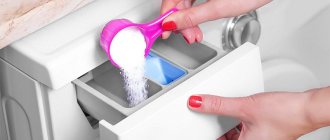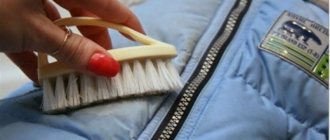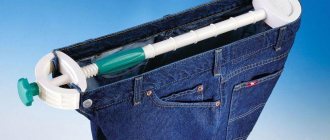If earlier it was almost impossible to drill holes in hard materials, and using a hand drill even when processing wood caused a lot of difficulties and required considerable physical effort, then with modern power tools everything has become much simpler.
To make holes of different depths and diameters in concrete slabs, bricks, foam blocks and other solid materials, drills and hammer drills with various attachments are widely used.
But in the process of processing materials, a kind of dust or flour is constantly formed. Consists of large and small particles. All this is scattered in different directions.
Now imagine that you need to drill a lot of holes. There is a lot of cleaning to be done after this. Or you need to install a TV on the wall, and the room has a beautiful, fresh renovation. My wife literally cleaned everything yesterday. And there are many similar examples. Both at home and at industrial facilities.
And the task is one: to minimize the amount of dust and dirt that is formed during the process of drilling walls with a hammer drill or drill.
Simple tricks
You can drill a hole in a wall made of concrete, brick or plaster or in a floor slab using a drill with a Pobedit drill bit or a hammer drill. To reduce the likelihood of fine particles spreading throughout the room, take the advice of professionals and find out how to drill a dust-free wall or ceiling:
- Use a vacuum cleaner when working. In this case, you will need an assistant. While one person drills the surface, the second holds the hose without a nozzle in close proximity to the drill. Using a vacuum cleaner it is possible to collect flying dust, but this option is only suitable for making shallow holes if you have a partner;
- Glue a paper envelope to collect dust. When drilling vertically, take a regular envelope (you can use it) or fold a sheet of A4 paper like a pocket, then attach the paper dust collector to the wall with masking tape;
- Place a plastic cup over the drill. The method is only suitable for making deep holes (from 5 to 12 cm) of large diameter in surfaces. Take a plastic or paper cup, make a hole in the bottom with a knife and put it on the drill. If necessary, cut the glass so that the heel of the drill remains inside. This technology is most often used to drill dust-free holes on the ceiling.
Tired of cleaning up dust and dirt after every drilled hole in your apartment? Thanks to our “life hacks” you will be able to drill holes without dust and debris!
In this article, we will offer several options that will help you drill a hole without dust.
It might seem like a simple device, but it really works. The point is simple: while drilling with a drill, you need to keep the vacuum cleaner hose turned on directly next to the hole ( it is better to remove the nozzle
).
As a result, all soap and debris from the hole will be sucked into the vacuum cleaner without polluting your apartment.
If you are doing a renovation and you need to drill a lot of holes, you can buy a special dust collector attachment for a drill, or make it yourself using improvised materials.
Drilling without debris: DIY devices
Just 10 or 15 years ago, when drilling walls and ceilings, builders had to either breathe dust (which is very bad for the respiratory system) or dodge, coming up with new options for dust collectors. Such homemade products are still in use today - professionals no longer use them, but for ordinary people who need to hang a picture or shelf every six months, this is a real way to keep their apartment clean.
Envelope
You can buy it at the post office or glue it from a sheet of paper. The only requirement is the shape: the envelope should be like the good old days, with a flap on top, not on the side.
Next you need to modify the product:
- Reduce valve height (if necessary).
- From the inside, stick a strip of masking tape or electrical tape onto the valve so that it protrudes beyond the paper. This will then allow you to attach the envelope to the wall. You cannot use regular tape - it will stick tightly to the wallpaper, come off along with the paint, or leave a dirty sticky mark on the surface.
- The back of the envelope (it will be directed into the room) is bent slightly vertically so that the envelope is slightly open - garbage will fall into this gap.
We recommend: How to remove old paint from a metal surface: 5 easy ways
The envelope will be usable until it breaks.
Analogues of drill bits
There is every reason to believe that the drill attachment mentioned above was made based on the dust collectors that our fathers and grandfathers used. To make such homemade products, everything that came to hand was suitable:
- plastic or paper glass;
- half a rubber ball;
- cut bottle or tin can;
- cake box lid.
The algorithm for their use did not change - a hole was made in the bottom along the diameter of the drill, an improvised dust collector was put on so that its open part was directed towards the wall or ceiling, and the necessary work was done. At the end, the garbage was carefully shaken out.
By the way, the ball and cake box are ideal for drilling ceilings.
Vacuum cleaner
- This method is a close relative of the vacuum dust collector, but instead of a special device that is mounted on the wall, you will need a spare pair of hands. In order not to stain the wallpaper and floor, you cannot do without an assistant - while one person operates the hammer drill, the second holds the vacuum cleaner hose (the brush is first removed from it) as close as possible to the place where the drill enters.
Do not forget that frequent use of this method may lead to the purchase of a new vacuum cleaner, since construction dust has a detrimental effect on the engine, and filters are not able to retain it.
These few methods, which allow you to avoid cleaning after drilling walls, are the most common, but the list of possible options is not limited to them. You yourself can come up with another option using what you happen to have lying around at home. Write your ideas in the comments!
Drilling with a hammer drill without dust or how to work with a hammer drill without dust
When drilling a hole in concrete or brick with a hammer drill, a lot of dust is generated. When construction processes are underway, this does not bother anyone. If you need to drill a hole in a residential, clean room, this becomes a problem. Dust, especially brick dust, will ruin wallpaper, upholstered furniture and other interior elements.
In this article we will discuss how to work with a hammer drill without dust. Or how to neutralize it during work.
Drilling holes with a hammer drill without dust.
Disadvantages when using a vacuum cleaner
Some people use a vacuum cleaner. This is a good option to avoid dust when drilling with a hammer drill, but not always acceptable. This device may not be at hand. It requires two people to operate it. One drills a hole with a hammer drill, the other holds the suction tube of the vacuum cleaner next to the working part of the drill. All dust is sucked into the vacuum cleaner. But you can’t handle this situation alone. It is inconvenient for one person to monitor two operating devices at the same time, holding their parts in the right places.
How to drill a wall without dust
To drill a wall with a hammer drill without dust, you will need two things: tape and a plastic bag, which are used for packaging.
It is preferable to use masking tape. Let's mark future holes on the wall in the right places. Place an open plastic bag under the mark on the wall with tape. It should be held in such a way that all the drilling dust falls inside it. You can drill carefully, the main thing is not to overdrive. Then the waste is poured into a bag.
As soon as you increase the speed of the hammer drill, some of the rot will be blown around by the air flow from the engine fan. If you hit it carefully, at low speeds, the process will go just fine. You will collect all the dust in a plastic bag. It can be used repeatedly.
An important point: the tape must be glued to the wall very tightly. Inadequate gluing will result in dust falling between the wall and the tape and staining the wallpaper.
How to drill a ceiling with a hammer drill without dust
Here the situation is more complicated. You can apply the same construction as described in the previous paragraph. But the effect will be worse. As an option, we use a disposable plate or a disposable plastic container, pierced in the middle with a drill. If you don’t increase the speed too much, then most of the debris when drilling the ceiling will end up in this additional element. During operation, this plastic part will need to be held with your hand to avoid its rotation.
Drilling with a hammer drill without dusting the ceiling.
The best option in this case would still be a vacuum cleaner.
In general, decide how to operate a hammer drill without dust in accordance with the situation.
buildip.ru
Why fight dust?
Dust is undesirable for many reasons:
- When dust enters the body, it causes health problems.
- Particles of cement or brick flour, getting into the gears of mechanisms, can damage them.
- When mixed with water, cement dust forms dirt that is difficult to wash off.
However, all these measures only reduce the damage. Devices that collect dust even as it forms can radically solve the problem.
Professional builders have in their arsenal a special tool to combat the resulting flour: an attachment on a drill or drill, to which a hose from a vacuum cleaner is connected. This addition to the hammer drill helps collect garbage very cleanly, but it has a number of disadvantages:
- You have to spend money to purchase a nozzle. Such expenses are appropriate if you have to drill constantly. But if you occasionally have to drill one or two holes in the ceiling or wall, it is irrational to buy a special nozzle.
- As a rule, using the nozzle requires the help of a partner who will hold the vacuum cleaner. In everyday life, improvised do-it-yourself devices are used to solve the same problems.
What do professionals use?
The range of dust collectors for rotary hammers and drills is quite extensive. These can be ready-made factory devices, or home-made devices.
In the case of professionals in the field of repair and construction, special solutions are provided for tools of this level. These are attachments installed on a drill or drill, allowing you to connect a hose from a vacuum cleaner to them. A kind of add-on that promotes fast and efficient garbage collection.
But professional dust collectors have certain disadvantages.
- Additional expenses. To acquire such an attachment, you will have to spend money. And not the smallest ones. This will be a profitable investment for those who drill regularly. But if you use a drill or hammer drill exclusively for household needs and literally pick up the tool 1-2 times a year, then such costs will be impractical.
- Need a partner's help. In order for a dust extractor to work effectively, it usually requires assistance from a partner. His job is to stand and hold the vacuum cleaner nearby.
Therefore, devices assembled from scrap materials have become popular in everyday life. You don't need to spend money on them. At the same time, they cope with their tasks perfectly. And you won’t have to look for an assistant.
My readers' experience
Tip 1
Half-mask respirators are complete rubbish. Spraying water does not clear the air of fine—the most dangerous and most volatile dust. If you have a partner and the opportunity, to reduce the FORMATION of dust, try spraying the grinder disk on the place where it fits into the groove being cut. Since pneumoconiosis is incurable, use RPE that is more effective than half masks (in order of increasing effectiveness): full-face masks with P3 filters (BUT so that the size matches your face), and they also have forced supply of clean or filtered air under the mask (so that unfiltered air did not leak through the gaps between the mask and the face - the main problem of RPE). The second option is more expensive, to put it mildly. The compromise is to work intermittently, tightening the headband fastening straps (to press the full face mask tightly against the face). In industry they use ventilation, but this is unlikely to suit you. Although drilling in the ceiling with a vacuum cleaner in one hand and a drill in the other is quite possible.
Tip 2
It was an experience. The apartment is residential. Renovation only in the kitchen. I moved the sockets, chiseled the walls (concrete) with just the same diamond disc as you have in the video, concrete with stones. Goal: to protect the apartment from dust; it is clear that in the kitchen itself there is a column of dust.
Option 1. Hang 2 sheets of dense polyethylene on the door with a large overlap of the wings vertically, with the ability to connect them with Velcro or a zipper. This option was prompted by the mobile chemical laboratory system. Polyethylene - so that dust rolls down. Dense - to walk on, so as not to tear. Velcro - to protect the passage and the gap in the middle. Apply tape around the perimeter of the door jamb. We didn’t get around to Velcro (there was no one to sew), and since the polyethylene is dense, the gaps still remained. I declined this option.
Option-2: The idea is the same, but instead of polyethylene I used 2 wet sheets, the tape around the perimeter of the door fell off by itself, and was replaced by nails and buttons. The overlap on the walls along the perimeter is 20-30 cm, in the middle of the passage it is also about 30 cm. Before dusty work, I removed it, wet it generously, and as it dried, sprayed it with a flower spray bottle. At the bottom, along the width of the door, I laid a wooden beam, pressed the sheets, provided tension, and thereby plugged the bottom gap. The main thing is that there is no draft in the apartment; all windows must be closed. At the end of the work (when the dust is thick and you are there), breathing all this goodness is harmful. I tried to spray the air to knock down dust, but the effect is weak + dirt appears. Additionally, he opened the window in the kitchen, put a fan opposite it to blow it out and went through the “wet barrier” into another room, waiting for the dust to settle. Result: dust seeped from the kitchen into the corridor and settled on the floor at a distance of about 3 meters (this was helped by the natural convection of air in the apartment), but beyond that there was no obvious dust. Daily cleaning of the corridor in the evening saved me from the displeased glance of my wife. Of course, and without fail, any renovation requires cleaning the entire apartment; dust appears always and everywhere. I hope someone will find my experience useful.
So, today we learned what construction dust is, where it comes from, and in what cases it occurs most often. How to protect your respiratory organs from it, how to work, protecting your furniture and other valuable accessories from it in the house.
How to drill without dust: options, the better
Construction work is always accompanied by dust and debris, but using some recommendations and tips, it can be significantly reduced:
- During operation, the hammer drill leaves a slight dust, so that it does not fly around the room, use a construction vacuum cleaner at the same time. Some brands of tools have a built-in vacuum cleaner, which makes the task easier;
- using a drill, it is best to either make a jig on the end or a bag, or make an envelope under the hole so that the debris falls into it.
How to drill holes in a brick wall: choosing tools and attachments
To make a hole in a brick wall, a hammer drill with a drill or an impact drill are suitable; the latter is most often used. Its power must be at least 600 watts, the minimum number of revolutions is from 2500 per minute. It is best to use a drill with continuously adjustable power and a quick clamp function.
Using the hammer drilling function, the drill becomes identical to a hammer drill. Increases speed and ease of operation. To make a hole in a brick wall you need to use the dynamic impact method. Without this, the drill will not be able to engage the inside of the brick.
How to drill a load-bearing wall with a hammer drill in a panel house
In most panel houses, the walls are made of concrete; in order to make a hole with a hammer drill, you need to use pobedit drills.
In addition to them, you can use special crowns. They have soldering around the circumference. When using them, you need to disable the hammer drill's impact function.
Specialists use diamond drilling, which requires powerful equipment and skills.
How to properly drill a reinforced concrete pipe with a hammer drill
When using an impact drill for reinforced concrete, you need to use the “perforator” mode and pobedit drills. First, the hole is made smaller, then larger. The drill needs to be cooled periodically.
Important! When working with concrete, you need to avoid hitting the reinforcement, otherwise the drill will break. Using a special device you can check where it is located
How to make a hole in a concrete wall with a drill
It is difficult to drill into a concrete wall with a conventional drill. You need to install victory drills and select low speeds. A dowel is inserted into the desired location to help the tool pierce the surface. Next, drilling should be alternated with striking the dowel.
If the drill does not have a speed control, then it will not be possible to make a hole.
How to make a hole in a concrete wall in an apartment with a drill
For a small hole, you can use a punch. Most conveniently, it can be made from a drill, 8 mm in diameter. The end is sharpened sharply. The drill is placed in the desired place, rotated, while simultaneously hitting it with a hammer. Wet the drill periodically to make it work longer.
Where does dust come from?
As a rule, hard materials are drilled with a hammer drill or impact drill. A drill, drill bit or other tool destroys the material and brings small particles to the surface. There is a special impeller inside the power tool. Rotating, it drives cold air towards the cartridge, cooling the engine and preventing the mechanism from clogging. However, the air flow disperses the dust to the sides, lifting it into the air.
Depending on the nature of the material, the dust will be more or less coarse. Homogeneity also differs: particles can have the same size or form several fractions.
The dust generated during drilling is hazardous to health. It can dust your eyes and get into your lungs when you breathe. To avoid such effects, it is necessary to wear a respirator, safety glasses and a hat when working.
Work rules: tips
When working with tools, you must follow safety rules and general recommendations:
- 1) When performing work, protect your respiratory system, dust is harmful.
- 2) If you work outside, you need to install fences at 2.5 meters.
- 3) When performing work at a height of more than 1.5 meters, use a strong base - scaffolding or a goat.
- 4) When working with a tool, the speed must be turned on smoothly, and in no case should it be turned off when it is in the body of the wall.
- 5) When drilling through plaster, you must carefully study the communication plan so as not to hit anything.
- 6) It is strictly forbidden to drill through the decorative coating.
- 7) Choose the right drill bits for each surface.
- Wet the drill with water to prevent it from overheating.
We drill holes in the ceiling and walls without dust.
Before this topic “Drilling (drilling) without dust,” I told you how to cut without dust using a grinder. This process was described in the article - Installation of grooves without dust *. Well, today I was asked to tell you how to do this only when working with a drill or hammer drill. So, go ahead for new knowledge and solutions, as methods will be presented that will allow you to drill and drill so that dust from under the drill does not fly around the room and, as a result, you do not have to spend a long time and tediously cleaning! + We'll tell you how to make sure that when drilling the ceiling (with a drill, a crown), concrete or plaster chips don't fall on your face!! Go
…
All builders face a problem when drilling, drilling holes in the ceiling and walls. When a hammer drill or drill sprinkles small or even large fractions of drilling waste, simply dust particles, into your eyes, onto the floor and pieces of furniture, as well as your hands.
So, I propose to deal with this small nuisance using the old-fashioned method, by putting a regular plastic or cardboard cup on a drill, drill, or cardboard!!
Just insert a drill through the center of the cup
, the cup faces completely towards the drilling and at the moment of drilling, crumbling dust, particles of the concrete fraction, will fall into the plastic cup, which will greatly simplify further cleaning of the apartment and protect your eyes from dust. Although you should have glasses for this matter. Well, if anything, it won’t get into your mouth!! :))
This method of drilling, drilling without dust, is suitable for drills or a drill no less than 10 centimeters long, including the heel of the drill! Otherwise, the selected container will need to be shortened in length.
You can also drill a wall without dust.
, only in this case a vacuum cleaner or a bag glued to the wall in the place where you are going to make a hole will help us.
At the moment when you are drilling a wall, your partner or yourself will have to place a vacuum cleaner under the hole. The vacuum cleaner will suck up all the dust coming out from under the drill and will not allow it to scatter or crumble. So we figured out how to drill a hole in the ceiling and wall without dust using a drill and a hammer drill.
Without resorting to the use of special drills with nozzles that draw in air, Americans do an excellent job.
When drilling a wall or ceiling, they do not use a plastic cup or a vacuum cleaner like we do, but a specially designed bag, into which all the fine particles fall during drilling.
This container is put on the drill and when the drill rotates, by analogy, production occurs along the grooves into the package. This is clearly visible in the photo below.
We drill a concrete ceiling without dust. How to drill a hole without dust
Many owners know how much cleaning there is due to dust and debris when drilling concrete or brick walls. How much do you have to move furniture, wash floors, wipe dust in a living space after drilling holes in the walls to install interior items such as shelves, lamps, paintings, etc.
One day my friend showed me an interesting way. For which I am very grateful to him. How to drill into a concrete wall without dust and debris? Maybe someone already knows this method or uses other devices, but I’ll tell you and show you anyway. So, everything in order.
Mark the space for the hole on the wall.
We make a small envelope-pocket device. To do this, take a sheet of A4 paper.
Fold a sheet of paper in the manner shown in the photos below.
Take masking tape.
We glue the tape so that we get an envelope in the form of an open pocket.
We glue the envelope on the wall as close as possible to the future hole.
We take a hammer drill with a drill of the required diameter. To better guarantee the cleanliness of the drilling, we take a household vacuum cleaner. After removing the brush attachment, apply the vacuum cleaner hose to the drilling site. Turn on the vacuum cleaner, preferably at full power. And drill a hole with a hammer drill.
You can call someone at home for help. But if there are no assistants, then in one hand you have a vacuum cleaner hose, and in the other hand a hammer drill. If the vacuum cleaner is powerful enough and the drilling diameter is small, then the envelope remains almost empty at the end of the job. Unfortunately noisy, but no dust or debris.
Concrete is the main building material from which most of all modern buildings are built. When renovating, a problem that often arises is how to drill into concrete? After all, reinforced concrete slabs are a material of increased strength, the processing of which requires knowledge and special tools. Below we will look in detail at how to quickly complete this procedure and what is needed for this.
Tool selection
You can drill concrete yourself using two tools: a hammer drill or an impact drill. For the first, processing of hard surfaces (concrete and stone) is a direct purpose. The hammer drill allows you to create large-diameter holes and is designed for fairly high loads. An impact drill, in turn, is designed for drilling holes up to 12 cm thick. It is indispensable when processing foam blocks, since a hammer drill is capable of completely crumbling a wall made of such material.
An impact drill can be safely used for processing concrete: it will allow you to make several holes without causing any damage. However, large-scale work requires specialized equipment. It is not recommended to use a conventional hammerless drill.
Cutting elements for concrete processing
To make holes in reinforced concrete blocks, it is necessary to use special drills, they are called pobedit drills. The tip of such a tool is coated with carbide coating. There is no point in saving on drills; a cheap tool will quickly fail at the most inopportune moment. You can drill concrete correctly only with special cutting elements designed for this purpose. Diamond-coated drills are also used. They are installed on special drilling rigs that create large holes with a diameter of 200 mm.
To arrange connectors for a switch or socket, crowns are used, which are a scaled-down model of diamond drills for drilling rigs. As a rule, their diameter is from 35 to 120 mm. Crowns allow you to drill holes up to 150 mm deep. When installing such an attachment on a hammer drill, you need to turn off the impact mode. Among the drill attachments there are similar bits. Their advantage is that they can be used to process several different materials. At the same time, drill bits are designed for devices with a power of at least 1000 W.
How to make a paper dust collector
How to drill concrete without dust using a dust collector
1. Cut out a blank from paper (see photo). There is no need to measure anything. Everything is done by eye, sometimes by trial and error.
2. Cut several strips of tape and stick one end to the edge of the table.
3. Take a drill, insert the drill into the chuck and wrap the paper around the chuck to make a funnel. The bottom of the funnel should be below the cartridge so that it remains stationary when it rotates. Tape the edges of the paper together.
4. Tape the funnel to the drill body. It’s easier to do this by using not one long strip of tape, but several short ones. You need to glue the strips of tape overlapping each other, so that there are no gaps through which dust could spill out.
This simple device will help you collect some of the dust when drilling holes in the ceiling.
Now let's look at a more progressive method: drilling concrete using a hammer drill equipped with a vacuum dust collector.
It is clear that such a solution will cost more than a paper funnel, but the result will be completely different. With such a tool, you can, without fear of dust, drill holes not only in the ceiling, but also in the walls and floor.
Recently I needed to make just one hole with a hammer drill in the wall for a dowel-nail.
I immediately remembered all the simple ways to avoid littering:
using a paper envelope attached to the wall with tape, and using a disposable cup.
These methods are time-tested, but I wanted to come up with an even more convenient way. By chance, the idea came to mind to use a sponge for washing dishes.
It has a number of advantages: it is accessible, reusable, holds dust well when wet, and serves as a kind of filter.
Hole in metal without drill
To drill through thin metal or plastic, you will need a screwdriver and a self-tapping screw with a cutting head. It comes in different lengths, it is better to take a short one.
- Mark the point on the surface where you will drill.
- Insert the screw into the screwdriver and carefully screw it all the way through
- At the same time, press down on it so that the tip cuts into the workpiece and pierces it.
The operation will only take a few minutes and the passage is ready. This self-tapping screw can cut several openings, then it needs to be replaced.
These tools are also suitable for drilling holes in wood. First you need to screw in a small screw, and then a larger one.
The better to drill
As already mentioned, there are several ways to drill through a concrete wall; let’s look at each of them in more detail.
Hammer
When using a hammer drill or impact drill, they must be switched to impact mode, a working tool with a pobedite tip is inserted and it must be directed perpendicular to the wall surface.
If drilling holes takes a long time, then periodically you need to wet the drill so that it does not overheat too much.
After you have drilled to the required depth, you must pull the working tool back without turning off the hammer drill. To clean the finished hole from dust, you need to deepen and pull out the drill several times.
A regular drill or screwdriver
If you do not have the tools described above, then this work can be done using a conventional electric drill or a powerful screwdriver.
Drilling will take more time than using a hammer drill, but you can do it yourself.
In this case, in addition to a drill and a drill bit, you will also need a punch. First, a small depression is made at the drilling site using a punch and a hammer.
After this, they insert the working tool into it and begin to drill. If the drill stops, break the hard areas again with a punch and continue working.
Although a regular electric drill or screwdriver is not suitable for working with concrete, if you don’t have a hammer drill, you can make several small holes with these tools, but you need to use a spear-shaped drill with a carbide tip, usually used for tiles.
Diamond drilling
This is the most effective way to quickly and easily make a hole of the required diameter in a concrete wall.
To perform the above work, you will need special equipment consisting of the following elements:
- electric motor;
- a stand that is securely fixed to the base;
- core drill.
There is no need to cool the drill during operation, as water is supplied to it, which not only cools the tool, but also prevents dust from forming.
If specialists work, then together with the specified equipment they use a vacuum cleaner, with which they remove dust and water.
Since the price of such equipment is very high, it is not advisable to buy it for domestic use. If it is necessary to make a hole of a large diameter, you can always invite specialists for this.
Independent production and use of a dust collector
Using the most ordinary household sponge will help fight dust even more effectively. To do this you will need: a bath sponge (or dishwashing sponge) and a stationery knife (scissors with sharp edges will also work). Exactly in the center of the sponge you need to draw a circle with a diameter of approximately 5 mm. Using a utility knife or scissors, cut through the foam to a solid backing. We carefully remove the foam rubber, and make a small hole in the backing, of such a diameter that a drill can fit into it.
Before you put the sponge on the drill, you need to wet it with water. In this case, the dust will settle much better on the damp surface of the sponge and will not scatter around the room. Just remember, after contact with water, the sponge should be wrung out so that it is damp, not wet.
Of course, all these devices will not be as effective as a professional hammer drill with a dust-catching attachment. But it won't cost you anything.
- Author: Sergey Petrov
Rate this article: (0 votes, average: 0 out of 5)
Industrial methods of dust protection
Vacuum dust collector
This device comes in two types:
- Mounted on a wall or ceiling - under the influence of suction force, it reliably “sticks” to any surface, even textured, and stays there as long as the vacuum cleaner is turned on. It has a hole in the middle through which a drill or crown passes (by the way, the diameter of the hole can vary, but for household needs 6–7 cm is usually enough).
- Mounted on a drill or drill - initially placed as close as possible to the drill head, and as drilling moves towards the body. The disadvantage of such dust collectors is that debris can still spill onto the floor, albeit in small quantities. However, one cannot fail to mention their advantage - such devices can be used even if you have to drill into a wall in hard-to-reach places.
By itself, such a dust collector will be a useless toy. A prerequisite for its operation is the presence of a powerful vacuum cleaner connected to a special connection. You can drill once or twice using the same vacuum cleaner that is used to clean the apartment, but for regular use it’s worth getting a “Rocket”, “Whirlwind” or “Buran”. The fact is that fine dust seeps through the filter system and settles in the engine. Modern specimens cannot withstand long and burn out, but the old Soviet monsters are almost indestructible.
Self-adhesive bags
They have a number of advantages:
- They are relatively cheap, so they are ideal for those who use a hammer drill only occasionally.
- Doesn't take up space in your toolbox.
- Transparent, so they do not interfere with the view.
- Completely prevents dust from getting on the floor.
- There are options for both a regular drill and a hole saw.
- Despite the fact that they are considered disposable, after the first use they retain their adhesive properties and can be reused (you just need to empty out the debris that has accumulated inside).
The only disadvantage of such packages is that they are completely unsuitable for drilling ceilings and other horizontal surfaces.
Drill bit
It looks like a cone that fits onto a drill. At first it is straightened out to its full length (the wide end rests against the wall, and the narrow end rests against the body of the drill), but as the drill moves deeper into the wall, it folds like an accordion. When using a drill with a long shank, you have to press the bit against the wall with your hand, which can be inconvenient.
Required Tools
Concrete structures have increased strength and contain particles of crushed stone, which is why they cannot be destroyed with a conventional drill bit.
READ Disassembling Bosch Rotary Hammer Buttons
During the process, the drill encounters areas of increased hardness and the work stops.
Therefore, impact drills or hammer drills are used for drilling.
But in domestic conditions, for a small amount of work, purchasing expensive tools is not advisable; a hole in concrete can be drilled without a hammer drill. At home, you can get by with a simple dorel with special attachments:
- Steel punch - used when a regular drill gets stuck in particularly strong areas. It is a special rod with a pointed end of increased hardness. The punch is inserted into the hole being made and hit with a hammer, crushing the most dense areas. You can also use a long drill with a Pobedit tip as a punch.
- Pobedite drill – has a tip made of metal, which is particularly durable. These drills are optimal for working on concrete. The drill tip is made of an alloy of carbide - tungsten and cobalt.
- Diamond-coated drill bit is a highly effective attachment for drilling crushed stone and beta. Diamond drills are installed on a conventional drill or on an impact drill when working with vibration turned off. The cost of diamond drills is quite high, so purchasing them for occasional use is not advisable.
- Tungsten carbide-coated bits are used exclusively with high-power drills. In everyday life, crowns with a diameter of 120 mm are used; professionals use attachments with a larger diameter. For concrete, experts recommend using crowns with separately soldered teeth. If there is iron reinforcement in the thickness of the wall, it is not recommended to use crowns, as the teeth will break off.
- CS: GO bits – crystalline diamond particles are applied to their edges, allowing drilling in concrete structures.
IMPORTANT. To obtain holes with a diameter of more than 12 mm and a depth of more than 110 mm, it is not recommended to use a conventional drill
Without a hammer drill or impact tool, it is impossible to make a large hole in concrete or a through hole.
Crazy Hands Method
Although the ancient invention offered for review has lost its relevance, in some extreme situations it can still be useful today, when you need to drill a hole without using a drill, which is simply not at hand. The authors of the program Crazy Hands suggest making an ancient instrument from new materials.
By the way, in another article, read about a device that can help you improve your work with a drill.
What do we need to create a hand drill?
– ballpoint pen with edges; – drill; – jar lid; – weights (nuts or other); – wooden plank; - rope.










